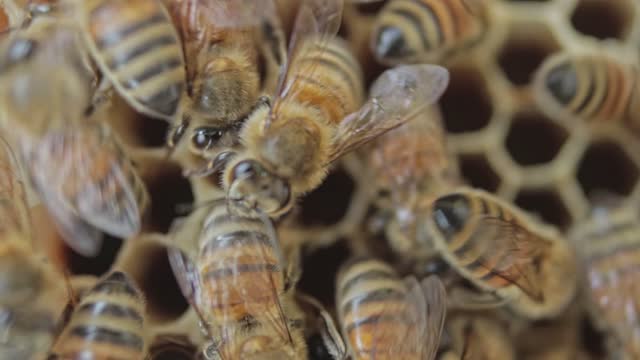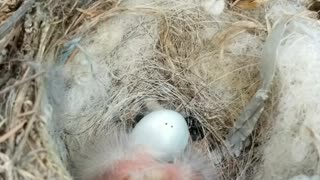Premium Only Content

close up view of bees in a honeycomb
The axes of honeycomb cells are always nearly horizontal, with the open end higher than the back end. The open end of a cell is typically referred to as the top of the cell, while the opposite end is called the bottom. The cells slope slightly upwards, between 9 and 14°, towards the open ends.
Two possible explanations exist as to why honeycomb is composed of hexagons, rather than any other shape. First, the hexagonal tiling creates a partition with equal-sized cells, while minimizing the total perimeter of the cells. Known in geometry as the honeycomb conjecture, this was given by Jan Brożek and proved much later by Thomas Hales. Thus, a hexagonal structure uses the least material to create a lattice of cells within a given volume. A second reason, given by D'Arcy Wentworth Thompson, is that the shape simply results from the process of individual bees putting cells together: somewhat analogous to the boundary shapes created in a field of soap bubbles. In support of this, he notes that queen cells, which are constructed singly, are irregular and lumpy with no apparent attempt at efficiency.
-
 0:10
0:10
brigond
4 years agoBirds Nest Baby Close Up View
25 -
 0:51
0:51
debblock
4 years agoReally close up view of northern flicker
25 -
 0:21
0:21
shawnswinea
4 years agoJackson close close up
38 -
 0:11
0:11
Shymol
5 years agoBeach view up close
152 -
 1:04:59
1:04:59
Man in America
15 hours ago“Summoning the Demon” — The AI Agenda Is FAR WORSE Than We Know w/ Kay Rubacek
61.5K46 -
 2:16:48
2:16:48
Tundra Tactical
13 hours ago $0.14 earned🎯💥 The World’s Okayest Gun Show 🔫😂 | LIVE Tonight on Rumble!
44.6K1 -
 3:36:03
3:36:03
Mally_Mouse
1 day ago🌶️ 🥵Spicy BITE Saturday!! 🥵🌶️- Let's Play: Tower Unite!
67K3 -
 58:59
58:59
MattMorseTV
13 hours ago $1.76 earned🔴Trump just BROKE Newsom.🔴
89.1K102 -
 18:14
18:14
Her Patriot Voice
13 hours agoWho Is WORSE for NYC: Trump Girl or Socialist?
66.2K36 -
 3:39:42
3:39:42
SavageJayGatsby
13 hours agoSpicy Saturday with Mally! | Road to 100 | $300 Weekly Goal for Spicy Bites!
59K1